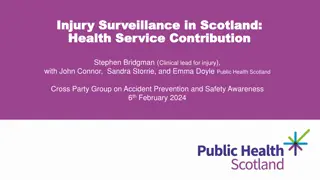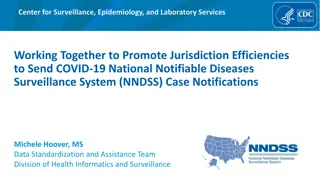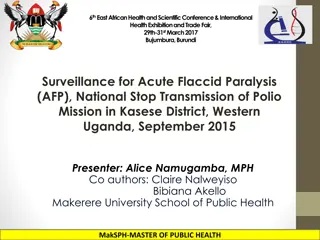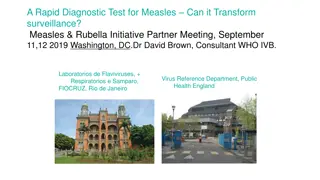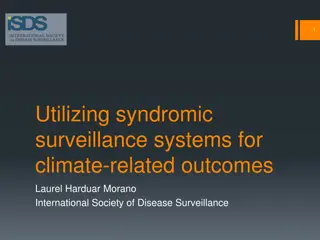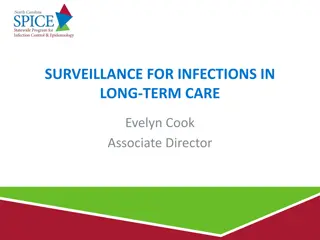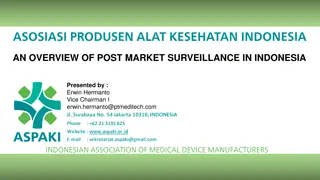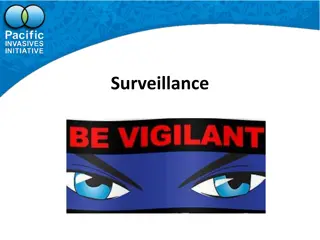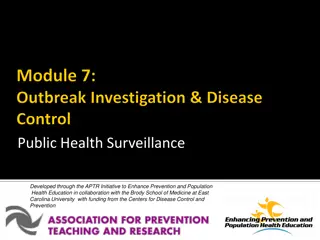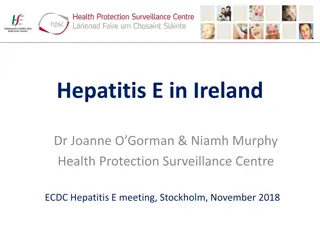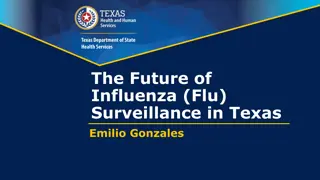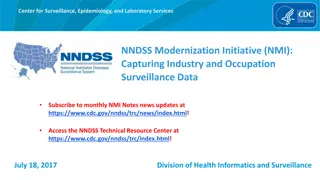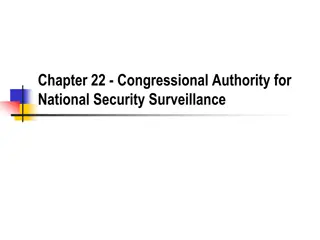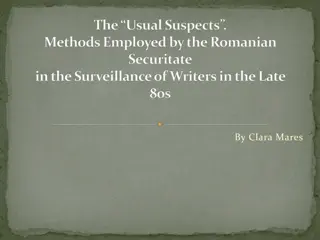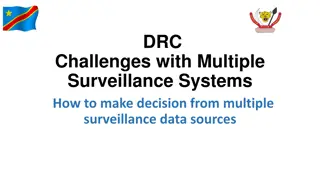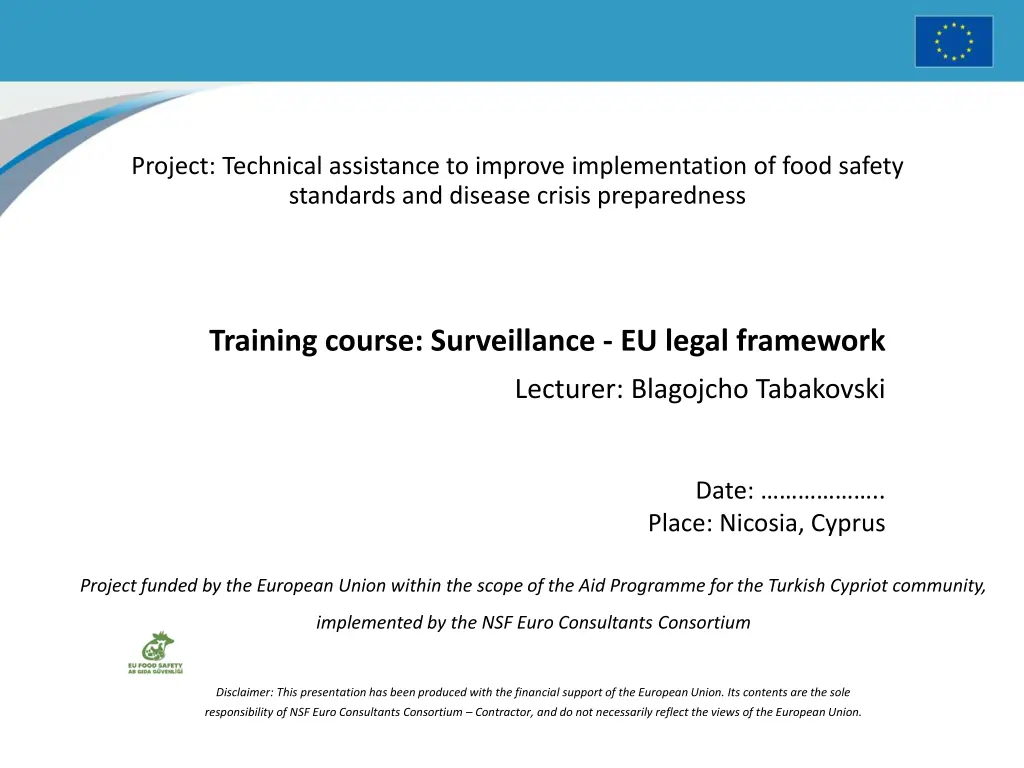
Enhancing Food Safety Standards and Disease Preparedness Training Overview
Learn about the EU legal framework on disease surveillance, including regulations, compulsory programs, eradication measures, and reporting obligations. Dive into the methodologies, surveillance methods, and disease-free status requirements for effective implementation. Gain insights on disease control measures and prevention strategies under the EU regulations. Complementing acts further enhance reporting and notification practices in the food safety sector.
Download Presentation

Please find below an Image/Link to download the presentation.
The content on the website is provided AS IS for your information and personal use only. It may not be sold, licensed, or shared on other websites without obtaining consent from the author. If you encounter any issues during the download, it is possible that the publisher has removed the file from their server.
You are allowed to download the files provided on this website for personal or commercial use, subject to the condition that they are used lawfully. All files are the property of their respective owners.
The content on the website is provided AS IS for your information and personal use only. It may not be sold, licensed, or shared on other websites without obtaining consent from the author.
E N D
Presentation Transcript
Project: Technical assistance to improve implementation of food safety standards and disease crisis preparedness Training course: Surveillance - EU legal framework Lecturer: Blagojcho Tabakovski Date: .. Place: Nicosia, Cyprus Project funded by the European Union within the scope of the Aid Programme for the Turkish Cypriot community, implemented by the NSF Euro Consultants Consortium Disclaimer: This presentation has been produced with the financial support of the European Union. Its contents are the sole responsibility of NSF Euro Consultants Consortium Contractor, and do not necessarily reflect the views of the European Union.
CONTENT Legal framework Surveillance Type of the programmes Content of the programmes Eradication Free status
Regulation (EU) 2020/429 AHL Articles 18-42 1. Disease notification and reporting 2. Surveillance Operator s obligations observe health, changes in the production parameters, abnormal mortalities Animal health visits for the purpose of prevention CA s obligation Presence of listed and emerging diseases 3. Methodology and frequency (disease profile, risk factors, health status in country and region ) 4. Eradication programs (compulsory and optional) 5. Disease-free status
Regulation (EU) 2020/429 AHL Articles 18-42 Content compulsory and optional eradication programs a description of the epidemiological situation of the listed disease a description and demarcation of the geographical and administrative area a description of the disease control measures of the eradication program a description of the organisation, supervision and roles of the parties involved in the eradication program the estimated duration of the eradication program the intermediate targets of, and the disease control strategies for implementing, the eradication program
Regulation (EU) 2020/429 AHL Articles 18-42 Measures under compulsory or optional programs Disease control measures or prevention of disease, Surveillance to determine the effectiveness of the control measures or freedom from listed disease, Measures to be taken in case of positive surveillance results,
Complementing implementing acts 1. CIR (EU) 2020/2002 on reporting and notification Disease notification and reporting: diseases, deadlines, notification regions Submission and reporting of eradication programs, Union surveillance programs Applications for disease freedom The computerised information system for Union notification and Union reporting of diseases 2.CIR (EU) 2020/690 laying down rules as regards the listed diseases subject to USP, their geographical scope and the listed diseases for which the disease-free status of compartments may be established 1.USP: Avian influenza (HPAI and LPAI viruses) 2.Compartments: diseases of aquatic animals 3.CIR(EU) 2021/620 listing disease free areas and areas with an approved program
Regulation (EU) 2020/2002 - information for the eradication programs - 1 Date of submission Name of the country Name of disease Territorial scope with a description and demarcation of the geographical and administrative areas A description of the epidemiological situation for each zone or region, the number of establishments keeping animals of the targeted animal population by health status the number of animals of the targeted animal population kept in the establishments maps indicating the density of the targeted animal population timeline with prevalence, incidence data and, where relevant, vaccination history covering at least the past 5 years; and information as regards the epidemiological situation in additional animal populations, where relevant
Regulation (EU) 2020/2002 - information for the eradication programs - 2 A description of the disease control strategy of the eradication program including at least (Article 16 of Reg. 2020/689): the sampling schemes and diagnostic methods to be used in accordance with for the granting of the disease-free status to establishments and the maintenance of that status; to confirm or rule out the disease in the event of a suspected case; the disease control measures to be applied in the event of a confirmed case; the biosecurity and risk mitigating measures to be implemented; type of vaccine(s) to be used and the vaccination scheme, if relevant; the measures to be implemented as regards additional animal populations, if relevant; the derogations to be applied if relevant; coordinated measures with other Member States or third countries, if relevant.
Regulation (EU) 2020/2002 - information for the eradication programs - 3 A description of the organisation, supervision and roles of the parties involved in the eradication program including at least: the authorities in charge of coordinating and supervising the implementation of the program; responsibilities of all stakeholders involved. The estimated duration of the eradication program. The intermediate targets of the eradication program including at least: the expected annual decrease of the number of infected establishments; the expected annual increase of the number of disease-free establishments; the expected vaccination coverage, where relevant.
Surveillance Regulation (EU) 2020/689 Article 3(1)(b) & 3(2)(b) Specific surveillance requirements in the following circumstances: Union surveillance programs (terrestrial only) Compulsory or optional eradication programs plus maintenance of disease freedom Disease control measures Movements (trade-imports) Approval of establishments Risk-based surveillance (aquatic only) Voluntary surveillance programs for Cat C diseases (aquatic only)
Official activities The competent authority shall, if relevant, include these official controls and other official activities include: ante-mortem and post-mortem inspections; inspections at border control posts; official controls and other official activities at markets and assembly operations; official controls and other official activities during transport of live animals; public health related inspections and sampling in establishments; any other official controls during which establishments, animals or samples are inspected or examined.
Diagnostic methods Regulation (EU) 2020/689 Article 6 From a prescriptive approach to a more flexible approach Specific legislation and guidance which will be made available in the websites of the EURL and COM OIE Manuals Art 34 of OCR National rules. In absence of national rules, relevant methods recommended by NRL validated in accordance with international standards or Relevant methods validated with inter or intra-laboratory methods validation studies In case of urgency, NRL (in absence, other designated lab) may use methods which have not been validated 4.Diagnostic methods for granting and maintaining disease freedom are laid down in Annexes III and VI
Case definition Regulation (EU) 2020/689 Annexes I & VI General definition Suspicion Clinical, post-mortem, laboratory examinations or results from a diagnostic method which are indicative of a particular disease Epidemiological link with a confirmed case Confirmation Isolation (excluding vaccine strains) Animal with clinical signs or with an epidemiological link with a suspected or confirmed case where: Antigen or nucleic acid (excluding vaccine strains) is identified or Positive to an indirect diagnostic method (excluding vaccinations strains) Specific definitions: HPAI, LPAI, NC in Annex I /Aquatic diseases in Annex VI
Union surveillance programmes Regulation (EU) 2020/689 Article 10 - 11 Obligation of the CA to perform surveillance for diseases that are relevant for the Union (Art 28 of AHL) For the time being, only HPAI (and LPAI) and Submitted to the Commission, but no need for approval (Art 28 of AHL) Content of the AI Union surveillance program: Annex II to Regulation (EU) 2020/689 Information for the submission of the programs and reporting obligations (Art 11 of Regulation (EU) 2020/689) Deadlines are in CIR (EU) 2020/2002 on reporting and notification Submission: 31 May Reporting: 15 March
Eradication programs AHL Part II, Chapter 3, Regulation (EU) 2020/689, Article 14 &15 (T) 48 &49 (AQ) Targets: intermediate and final to show progress towards eradication or its achievement Duration: for optional programs maximum of 6 years Deadlines CIR (EU) 2020/2002 on reporting and notification Submission: 31 May 2021 (compulsory) - any time (optional) Reporting: 30 April Content of submitted programs and reports (CIR (EU) 2020/2002)
Eradication programs - terrestrial Based on granting disease free status at the level of establishments Cat B diseases (terrestrial): MTBC, infection with Brucella abortus, B. melitensis and B. suis Cat C diseases (terrestrial): EBL, IBR/IPV, ADV, BVD Based on granting the disease-free status at an area level Cat B diseases: infection with RABV Cat C diseases: infection with BTV
BTV Regulation (EU) 2020/689, Article, 37-45 Annex V, Part II To eradicate all serotypes All MS or minimum of 150 km around infected establishment (derogations) Based on vaccination (unless risk assessment justifies the contrary) Disease control measures Movement restrictions into areas free or under a program Movements that always are to be accepted Movements that may be accepted: no bilateral agreements Annex Surveillance Movement requirements Granting and maintaining the status
Disease freedom AHL Part II, Chapter 4, Regulation (EU) 2020/689, Part II, Chapter 4 MS, zone or compartment level (only aquatic animals) Several pathways Absence of listed species Disease agent s incapacity to survive Incapacity to survive of listed vectors for listed diseases of terrestrial animals Based on historical and surveillance data Based on eradication programs Specific rules for certain aquatic compartments which are independent of surrounding waters Details for the submission in CIR (EU) 2020/2002 on reporting and notification
Disease freedom based on historical and surveillance data Regulation (EU) 2020/689 Articles 70 &76 Never reported or was eradicated more than 25 years ago Reported in the last 25 years and eradicated in accordance with the eradication criteria of this Regulation Only possible in a new MS or for a newly categorised disease for a period of 2 years Particular cases: Rabies and infection with BTV Varroa and status free from infections with Newcastle virus without vaccination BVD, infection with Bonamia exitiosa, Infection with WSSV
Exercise Task 1 Program for LSD Task 2 Program for BTV
CONTACT Project e-mail: foodsafetyprojectTCc@gmail.com THANK YOU FOR YOUR ATTENTION Project funded by the European Union within the scope of the Aid Programme for the Turkish Cypriot community, implemented by the NSF Euro Consultants Consortium


